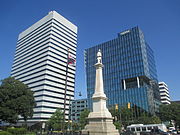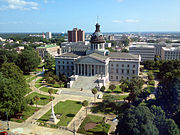Modern display of the Confederate battle flag: Difference between revisions
with the "Southern cross" canton used in battle flag of the Army of Tennessee now the dominant emblem of the Confederacy |
No edit summary |
||
| Line 87: | Line 87: | ||
In Georgia, the Confederate battle flag was reintroduced as an element of the [[Flag of Georgia (U.S. state)#The 1956 flag|state flag]] in 1956, just two years after the Supreme Court decision ''[[Brown v. Board of Education]]''. It was considered by many to be a protest against school desegregation.<ref>"[http://edhelper.com/ReadingComprehension_54_1473.html Confederate Flag Controversy]", Education Helper, by Sharon Fabian</ref> It was also raised at the [[University of Mississippi]] (Ole Miss) during protests against integration of schools.<ref>"[http://americanhistory.si.edu/brown/history/6-legacy/deliberate-speed.html With All Deliberate Speed]", Smithsonian</ref> |
In Georgia, the Confederate battle flag was reintroduced as an element of the [[Flag of Georgia (U.S. state)#The 1956 flag|state flag]] in 1956, just two years after the Supreme Court decision ''[[Brown v. Board of Education]]''. It was considered by many to be a protest against school desegregation.<ref>"[http://edhelper.com/ReadingComprehension_54_1473.html Confederate Flag Controversy]", Education Helper, by Sharon Fabian</ref> It was also raised at the [[University of Mississippi]] (Ole Miss) during protests against integration of schools.<ref>"[http://americanhistory.si.edu/brown/history/6-legacy/deliberate-speed.html With All Deliberate Speed]", Smithsonian</ref> |
||
Supporters of the flag's continued usage claim it is a symbol of Southern ancestry and heritage as well as representing a distinct and independent cultural tradition of the Southern United States from the rest of the country. Some groups use the "southern cross" as one of the [[symbol]]s associated with their organizations, including groups such as the [[Ku Klux Klan]].<ref>{{harvnb|Martinez|Richardson||McNinch-Su|2000|p=15}}</ref> For other supporters, the flag represents only a past era of southern sovereignty.<ref> |
Supporters of the flag's continued usage claim it is a symbol of Southern ancestry and heritage as well as representing a distinct and independent cultural tradition of the Southern United States from the rest of the country. Some groups use the "southern cross" as one of the [[symbol]]s associated with their organizations, including groups such as the [[Ku Klux Klan]].<ref>{{harvnb|Martinez|Richardson||McNinch-Su|2000|p=15}}</ref> For other supporters, the flag represents only a past era of southern sovereignty.<ref>{{cite journal |last1=Cerulo |first1=Karen A. |title=Symbols and the world system: National anthems and flags |journal=Sociological Forum |volume=8 |issue=2 |year=1993 |pages=243–71 |doi=10.1007/BF01115492 |jstor=684637 }}</ref> Some historical societies, such as the [[Sons of Confederate Veterans]] and the [[United Daughters of the Confederacy]], also use the flag as part of their symbols. Some [[rockabilly]] fans hold the battle flag as their emblem as well.<ref name="bad.eserver.org">Rentschler, Carrie (December 2005). [http://bad.eserver.org/issues/2006/74/rentschler.html The Confederate Flag in East Montreal]. Bad Subjects.</ref> |
||
As a result of these varying perceptions, there have been a number of political controversies surrounding the use of the Confederate battle flag in Southern [[Flags of the U.S. states|state flags]], at sporting events, at Southern universities, and on public buildings. In their study of Confederate symbols in the contemporary Southern United States, the Southern political scientists James Michael Martinez, William Donald Richardson, and Ron McNinch-Su wrote: |
As a result of these varying perceptions, there have been a number of political controversies surrounding the use of the Confederate battle flag in Southern [[Flags of the U.S. states|state flags]], at sporting events, at Southern universities, and on public buildings. In their study of Confederate symbols in the contemporary Southern United States, the Southern political scientists James Michael Martinez, William Donald Richardson, and Ron McNinch-Su wrote: |
||
Revision as of 11:46, 9 July 2015
The display of flags used by and associated with the Confederate States of America (1861–1865) has continued into the present day, with the "Southern cross" canton used in battle flag of the Army of Tennessee now the dominant emblem of the Confederacy. Such displays have been made for a variety of reasons, with Southern culture, conservative politics, and historical recreation among the stated reasons for particular uses. Displaying the flag has long been controversial, due to the flag's association with racism, slavery, and white supremacy.
Confederate national flags
The Confederate States of America used three national flags during the American Civil War. The latter two flags used incorporated the "Southern cross" canton that was widely recognized as a symbol of the Confederacy by 1863.
The "Confederate flag"
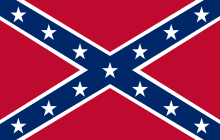

Designed by William Porcher Miles, the chairman of the Flag and Seal Committee of the Confederate Provisional Congress, the now-popular variant of the Confederate flag was rejected as the national flag in 1861. The design was instead adopted as a battle flag by the Army of Northern Virginia under General Robert E. Lee.[1] Despite never having historically represented the confederacy as a country nor officially recognized as one of the national flags, it is commonly referred to as "the Confederate Flag" and has become a widely recognized symbol of the American South.[2] It is also known as the "rebel flag", "Dixie flag", and "Southern cross" and is often incorrectly referred to as the "Stars and Bars".[3] (The actual "Stars and Bars" is the first national flag, which used an entirely different design.) The self-declared Confederate exclave of Town Line, New York, lacking a genuine Confederate flag, flew a version of this flag prior to its 1946 vote to ceremonially rejoin the Union.
20th-century resurgence
During the first half of the 20th century, the Confederate flag enjoyed renewed popularity. During World War II some U.S. military units with Southern nicknames, or made up largely of Southerners, made the flag their unofficial emblem. The USS Columbia flew a Confederate Navy Ensign as a battle flag throughout combat in the South Pacific in World War II. This was done in honor of Columbia, the ship's namesake and the capital city of South Carolina, the first state to secede from the Union. Some soldiers carried Confederate flags into battle. After the Battle of Okinawa a Confederate flag was raised over Shuri Castle by a Marine from the self-styled "Rebel Company" (Company A of the 1st Battalion, 5th Marines). It was visible for miles and was taken down after three days on the orders of General Simon B. Buckner, Jr. (son of Confederate general Simon Buckner, Sr.), who stated that it was inappropriate as "Americans from all over are involved in this battle". It was replaced with the regulation, 48-star flag of the United States.[4] By the end of World War II, the use of the Confederate flag in the military was rare.[5]
The 1948 Dixiecrat political party extensively used Confederate symbols, including the battle flag, and contributed to the flag's post-World War 2 re-popularization.[6] The 1979–1985 American television series The Dukes of Hazzard, set in a fictional Georgia county, featured the General Lee stock car with a prominently displayed Confederate naval jack on its roof throughout the series' run. In the 1994 movie, Forrest Gump, a Confederate flag can be seen at a US Army camp in Vietnam.
Use in state flags
Alabama
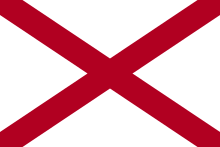
It has been hypothesized that the crimson saltire of the flag of Alabama was designed to resemble the blue saltire of the Confederate Battle Flag. The legislation that created the state flag did not specify if the flag was going to be square or rectangular.[7] The authors of a 1917 article in National Geographic expressed their opinion that because the Alabama flag was based on the Battle Flag, it should be square.[8] In 1987, the office of Alabama Attorney General Don Siegelman issued an opinion in which the Battle Flag derivation is repeated, but concluded that the proper shape is rectangular, as it had been depicted numerous times in official publications and reproductions.[9]
However, the saltire design of the Alabama state flag also bears resemblance to several other flags. It is identical to the flag of Saint Patrick, incorporated into the Union Flag of the United Kingdom to represent the union of the Kingdom of Great Britain with the Kingdom of Ireland. Except for the Great Seal in the center, it is almost identical to the Flag of Florida, which has its heritage in the Spanish Cross of Burgundy flag, which was used in southern Alabama until the 1800s.
Another slim possibility is in the flag of Co. F 7th Regiment Alabama Cavalry. The regiment was the only Alabama regiment in Rucker's Brigade commanded by Col. Edmund Rucker of Tennessee, later Alabama, who became a prominent Montgomery businessman after the war. The flag of the brigade used a white background with a red saltire which did not always extend to the corners and charged with dark colored stars upon the saltire. The flag of Co. F, 7th Alabama Cavalry is currently held by the Alabama Department of Archives and History as part of its Alabama Civil War Period Flag Collection.[10] But, the flag carried by Co. F 7th Alabama was not an Alabama Flag, it was the flag made for Rucker's Brigade a month before the 7th joined his brigade; the 7th was color party only after September 24, 1864. A bunting flag that exists, in the white and red configuration with 13 blue stars, is not believed to be Alabama associated, but tied to Rucker's Brigade.
Georgia

In 1956 the Georgian state flag was redesigned to incorporate the Confederate battle flag. Following protests over this aspect of the design in the 1990s by the NAACP (National Association for the Advancement of Colored People) and other groups, efforts began in the Georgia General Assembly to remove the battle flag from the state flag's design. These efforts succeeded in January 2001 when Georgia Governor Roy Barnes pushed through a design that, though continuing to depict the Battle Flag, greatly reduced its prominence. This move deeply angered a large segment of Georgia's electorate, contributing to Barnes' defeat in the subsequent gubernatorial election in November 2002.
The following year, amidst dwindling demands for the return of the 1956 design ("Battle Flag" version) and lesser opposing demands for the continued use of the new "Barnes'" design, the Georgia General Assembly redesigned the flag yet again; it adopted a "compromise" design using the 13-star First National Flag of the Confederacy (the "Stars and Bars"), combined with a simplified version of Georgia's state seal placed within the circle of 13 stars on the flag's canton.

Mississippi
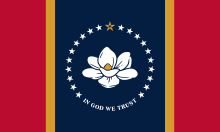
The Confederate battle flag became a part of the flag of Mississippi in 1894. In 1906 the flag statutes were omitted by error from the new legal code of the state, leaving Mississippi without an official flag. The omission was not discovered until 1993, when a lawsuit filed by the NAACP regarding the flag was being reviewed by the Supreme Court of Mississippi. In 2000 Governor Ronnie Musgrove issued an executive order making the flag official, which it did in February 2001. After continued controversy, the decision was turned over to citizens of the state, who, on April 17, 2001, voted 2:1 to keep the Confederate Battle Flag a part of the current state flag.[11]
Following the Charleston church shooting and subsequent discussion of the flying of the Confederate Battle Flag at the South Carolina State House, Speaker of the Mississippi House of Representatives Philip Gunn publicly called for the removal of the Confederate Battle Flag from the flag of Mississippi.[12]
State seals
The first Confederate flag, along with five other flags appears on the reverse of the Seal of Texas, it is also flown along with five other flags in Austin. Both are meant to describe the six countries that had sovereignty over Texas.
The Alabamian coat of arms features the Confederate battle flag's saltire in its design. Similar to Texas, the saltire on the coat of arms represents one of the five countries which have held sovereignty over part or all of Alabama.
Use on vehicular license plates
In Alabama, Georgia, Louisiana, Maryland, Mississippi, North Carolina, South Carolina, Tennessee, Virginia, vehicle owners can request a state-issued license plate featuring the Sons of Confederate Veterans logo, which incorporates the square Confederate battle flag.[13]
In 1998, a North Carolina appellate court upheld the issuance of such license plates in the case Sons of Confederate v. DMV, noting: "We are aware of the sensitivity of many of our citizens to the display of the Confederate flag. Whether the display of the Confederate flag on state-issued license plates represents sound public policy is not an issue presented to this Court in this case. That is an issue for our General Assembly."[14]
In 2015, the dispute over Texas vanity plates that would have borne the logo ended up before the United States Supreme Court, in a case pitting nationally famous free-speech advocates against those who view the battle flag as a symbol of hatred.[15] The United States Supreme Court ruled that license plates are governmental speech, and the government may decide what to have printed on the license plates.[16] A state may choose not to have a certain message on vanity license plates that it issues.[16]
Controversy
The Confederate flag is a controversial symbol for many Americans today. A 2011 Pew Research Center poll revealed that 30% of Americans have a "negative reaction" when "they see the Confederate flag displayed."[17] According to the same poll, 9% of Americans have a positive reaction. A majority (58%) have no reaction. In April 2013, a country song called "Accidental Racist" by Brad Paisley and rapper LL Cool J sparked a big media controversy about the use of the confederate flag.[18][19] In a October 2013 YouGov poll, a plurality (38%) of those polled disapproved of displaying the flag in public places.[20] In the same poll, a plurality (44%) of those asked viewed the flag as a symbol of racism, with 24% viewing it as exclusively racist and 20% viewing it as both racist and symbolic of pride in the region.[20]
In Georgia, the Confederate battle flag was reintroduced as an element of the state flag in 1956, just two years after the Supreme Court decision Brown v. Board of Education. It was considered by many to be a protest against school desegregation.[21] It was also raised at the University of Mississippi (Ole Miss) during protests against integration of schools.[22]
Supporters of the flag's continued usage claim it is a symbol of Southern ancestry and heritage as well as representing a distinct and independent cultural tradition of the Southern United States from the rest of the country. Some groups use the "southern cross" as one of the symbols associated with their organizations, including groups such as the Ku Klux Klan.[23] For other supporters, the flag represents only a past era of southern sovereignty.[24] Some historical societies, such as the Sons of Confederate Veterans and the United Daughters of the Confederacy, also use the flag as part of their symbols. Some rockabilly fans hold the battle flag as their emblem as well.[25]
As a result of these varying perceptions, there have been a number of political controversies surrounding the use of the Confederate battle flag in Southern state flags, at sporting events, at Southern universities, and on public buildings. In their study of Confederate symbols in the contemporary Southern United States, the Southern political scientists James Michael Martinez, William Donald Richardson, and Ron McNinch-Su wrote:
The battle flag was never adopted by the Confederate Congress, never flew over any state capitols during the Confederacy, and was never officially used by Confederate veterans' groups. The flag probably would have been relegated to Civil War museums if it had not been resurrected by the resurgent KKK and used by Southern Dixiecrats during the 1948 presidential election.[26]
Southern historian Gordon Rhea further wrote in 2011 that:
It is no accident that Confederate symbols have been the mainstay of white supremacist organizations, from the Ku Klux Klan to the skinheads. They did not appropriate the Confederate battle flag simply because it was pretty. They picked it because it was the flag of a nation dedicated to their ideals: 'that the negro is not equal to the white man'. The Confederate flag, we are told, represents heritage, not hate. But why should we celebrate a heritage grounded in hate, a heritage whose self-avowed reason for existence was the exploitation and debasement of a sizeable segment of its population?[27]
Symbols of the Confederacy remain a contentious issue across the United States and their civic placement has been debated vigorously in many southern U.S. state legislatures since the early 1990s, such as the effort that led to the replacement of Georgia's flag in 2001.[28] Supporters have labeled attempts to display the flag as an exercise of free speech in response to bans in some schools and universities, but have not always been successful in court[29] when attempting to use this justification.
2015 developments
On June 18, the day after a deadly church shooting in Charleston, South Carolina, believed to have been perpetrated by a white supremacist, many flags, including those at the South Carolina State House, were flown at half-staff. The Confederate battle flag flying over the South Carolina Confederate Monument[30] near the state house was not, as South Carolina law prohibits alteration of the flag without the consent of two-thirds of the state legislature.[31] Also, the flagpole lacks a pulley system, meaning the flag cannot be flown at half-staff, only removed.[31]

In June 2015, the National Park Service ceased flying Confederate flags over Fort Sumter.[32]
Display at South Carolina's state capitol
The Confederate battle flag was raised over the State House on April 11, 1961 at the request of Representative John May as a part of opening celebrations of the Confederate War Centennial according to Dr. Daniel Hollis, an appointed member of the centennial commission. Many historians point out that the appearance of the flag likely had a more nefarious purpose: to symbolize Southern defiance in the face of a burgeoning Civil Rights Movement. As Time magazine later noted, the move was “a states’-rights rebuff to desegregation.”[33] Lawmakers passed a resolution in March 1962 directing the flag be flown over the State House.[34][35][36]
On April 12, 2000, the South Carolina State Senate passed a bill to remove the Confederate flag from the top of the State House dome by a majority vote of 36 to 7.[37] "...[T]he new bill specified that a more traditional version of the battle flag would be flown in front of the Capitol next to a monument honoring fallen Confederate soldiers." The bill also passed the state's House of Representatives, but not without some difficulty. On May 18, 2000, after the bill was modified to ensure that the height of the flag's new pole would be 30 feet (9 m), it was passed by a majority of 66 to 43.[38] Governor Jim Hodges signed the bill into law five days later after it passed the state Senate. On July 1, 2000 the flag was removed from atop the State House by two students (one white and one black) from The Citadel; a more historically accurate Confederate battle flag was then raised on a 30-foot pole on the front lawn of the Capitol next to a slightly taller monument honoring Confederate soldiers[39] who died during the Civil War. Current state law prohibits the flag's removal from the State House grounds without additional legislation.
In 2005, two Western Carolina University researchers found that 74% of African-Americans polled favored removing the flag from the State House altogether.[40] The NAACP and other civil rights groups have attacked the flag's continued presence at the state capitol. The NAACP maintains an official economic boycott of South Carolina, citing its continued display of the battle flag on its State House grounds, despite an initial agreement to call off the boycott after it was removed from the State House dome.[41]
In 2000, the National Collegiate Athletic Association "announced that it will cancel future Association-sponsored events in South Carolina if that state doesn't take action to remove the Confederate battle flag from atop its state capitol." The association said that "many coaches and student-athletes feel that an inhospitable environment is created by the display of the Confederate flag over the South Carolina state house", and its chair said "there is no question that to a significant number of our constituents, the flag is a symbol of oppression." This has prevented South Carolina from hosting any championship sporting events in which the sites are determined in advance.[42] This NCAA ban on post-season championships in South Carolina has been strictly enforced, with the exception of HBCU Benedict College. In both 2007 and 2009, the school hosted the post-season Pioneer Bowl game, in violation of the NCAA ban, though no action was taken.[43] On April 14, 2007, Steve Spurrier, coach of the University of South Carolina football team, made an acceptance speech for a community service award in which he referred to the flag on the State House grounds as "that damn flag." This statement was also inspired by the actions of, as Spurrier said, "some clown" who waved the battle flag while being videotaped for SportsCenter.[44] On July 6, 2009, the Atlantic Coast Conference announced a decision to move three future baseball tournaments out of South Carolina citing miscommunications with the NAACP concerning the display of the Confederate flag in the state.[45]
Following the Charleston church shooting in 2015, many commentators questioned the continued display of the flag at the memorial on the State House grounds.[46][47][48][49][50] On June 22, South Carolina Governor Nikki Haley called for the flag's removal from state house grounds.[51] Later that week activist Bree Newsome climbed the 30ft flagpole to remove it herself, but was arrested after returning to the ground. The flag was raised once again moments later.[52]
Calls to remove the Confederate flag from statehouse grounds, as well as debates over the context of its symbolic nature, were renewed after the attack[53][54] by several prominent figures, including President Barack Obama, Mitt Romney, and Jeb Bush.[55] On June 20, several thousand people gathered in front of the South Carolina State House in protest. An online petition at MoveOn.org encouraging the removal of the flag had received over 370,000 signatures by that time.[56]
At a statehouse press conference on June 22, 2015, Governor Nikki Haley, flanked by elected officials of both parties, including U.S. Republican senators Lindsey Graham and Tim Scott, and former Republican Governor Mark Sanford, called for the flag to be removed by the state legislature, saying that while the flag was "an integral part of our past, it does not represent the future" of South Carolina.[57] "We are not going to allow this symbol to divide us any longer," she said. The legislature, scheduled to meet the following day for a budget session, must vote by a two-thirds majority to extend debate to the flag issue, and by two-thirds to remove the flag from statehouse grounds,[58] although the legality of that provision has been questioned by some lawmakers.[59] Haley said she would call for a special session if the legislature did not act.[57]
"With the winds that started blowing last week, I figured it would just be a matter of time," said Ken Thrasher, speaking for the South Carolina division of the Sons of Confederate Veterans, which opposes the flag's removal. "Whatever the Legislature decides to do, we will accept it graciously."[59] A number of prominent Republicans who had previously appeared to struggle with the issue immediately endorsed Haley's call to remove the flag, including Kentucky Senator and Majority Leader Mitch McConnell, Republican National Committee chairman Reince Priebus, and governors and presidential hopefuls Scott Walker and Rick Perry.[60]
On June 23, 2015, the South Carolina General Assembly added discussion of the flag to its special-session agenda in a procedural vote that indicated broad bipartisan support to remove the flag from the Statehouse grounds. The motion carried by a unanimous voice vote in the state senate and by a 103-10 vote in the state house. In the senate chamber, the desk of Clementa Pinckney, the pastor and state senator who died in the attack, was draped in black cloth with a white rose atop it. Among the legislators speaking in favor of removing the flag was Republican State Senator Paul Thurmond, son of Senator Strom Thurmond, who ran as a segregationist candidate for president in 1948.[61][62]
That same day, three state governors—Terry McAuliffe of Virginia (a Democrat), Pat McCrory of North Carolina (a Republican), and Larry Hogan of Maryland (a Republican) announced plans to seek discontinuation of their states' Confederate-flag specialty license plates. In addition to the Charleston killings, the governors cited the U.S. Supreme Court's decision in Walker v. Texas Division, Sons of Confederate Veterans, issued days earlier, in which the Court affirmed that states are not constitutionally obligated to issue Confederate specialty plates.[63]
On June 24, 2015, Robert Bentley, governor of Alabama, ordered the removal of the Confederate flag from a memorial on the state capitol grounds. A spokeswoman for Governor Robert Bentley told the Montgomery Advertiser on Wednesday that he did not want the flag to be a "distraction".[64] Speaking with AL.com, Bentley said he made the decision himself to take the flag down.[65]
Eulogizing the Rev. Clementa Pinckney on June 26, 2015, before 5,000 congregants at the College of Charleston, President Barack Obama acknowledged that the shooting had catalyzed a broad movement, backed by Republicans and Democrats, to remove the flag from official public display. "Blinded by hatred, [the gunman] failed to comprehend what Reverend Pinckney so well understood: the power of God's grace," Obama said. "By taking down that flag we express God's grace. But I don't think God wants us to stop there."[66][67]
On July 6, 2015, the South Carolina Senate voted to remove the Confederate flag from display outside the South Carolina State House. Following 13 hours of debate, the vote in the House to remove it was passed by a two-thirds majority (94-20) on July 8. The state governor's signature is expected for final approval.[68][69][70]
Retailer bans
Following the Charleston church shooting, the retailer Walmart announced that it would no longer sell items with the Confederate flag on them.[71] In a statement to the press, Walmart stated that "We never want to offend anyone with the products that we offer. We have taken steps to remove all items promoting the Confederate flag from our assortment - whether in our stores or on our web site."[72][73]
Shortly afterward, a number of other retailers, including Amazon.com, eBay, Etsy, Sears (which also operates Kmart) and Target announced that they would also be removing Confederate flag items from sale.[74][75] Google also pulled Confederate flag merchandise from their shopping site.[76]
Valley Forge Flag, Annin Flagmakers, Eder Flag and the Dixie Flag Manufacturing Company, four of the largest U.S. flag manufacturers, also announced that they would cease selling Confederate flags.[76][77][78][79]

Warner Bros. announced that they were halting production of the Dukes of Hazzard "General Lee" toy cars, which prominently featured a Confederate flag on the roof of the car.[80] Reruns of the Dukes of Hazzard television show were also pulled from TV Land's schedule due to the controversy.[81] On July 2, 2015, professional golfer Bubba Watson announced that he would modify the General Lee car that he purchased at auction by painting an American flag over the Confederate flag that had appeared on the car's roof since it was customized for the TV series in 1978.[82][83]
Also in June 2015, Apple Inc. also began removing apps featuring the flag,[84] Several U.S Civil War-based games were initially removed, but Apple later announced that they were only targeting apps "that use the Confederate flag in offensive or mean-spirited ways" and was working with developers who felt that their apps were wrongly removed.[84][85]
The U.S. National Park Service announced that it is requesting that its retail partners stop selling the Confederate flag, as well as other items that depict the flag as a stand-alone feature.[86][87]
NASCAR
Following the Charleston church shooting, the American auto racing sanctioning body NASCAR, which has roots in the Southern United States and has many fans who fly the Confederate flag at campsites, supported Governor Haley in removing the Confederate flag from the South Carolina State House. In addition, NASCAR chairman Brian France vowed the sanctioning body would not associate themselves with the flag and wanted to eliminate the flag from races. NASCAR drivers Dale Earnhardt, Jr. and Jeff Gordon, along with team owner Brad Daugherty (the only African American team owner in NASCAR), also supported eliminating the Confederate flag from racing events.[88] Prior to the Coke Zero 400 race at Daytona International Speedway on July 5, 2015, the track announced fans can voluntarily exchange Confederate flags for American flags.[89] On July 2, 2015, the NASCAR tracks issued a joint statement calling for fans to refrain from flying the Confederate flag at races.[90]
See also
- Strafgesetzbuch section 86a, the German legal codes regulating the modern display of past "unconstitutional organizations" within Germany




